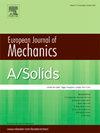具有剪切变形效应的尖端附体高速旋转悬臂梁的振动与稳定性
IF 4.2
2区 工程技术
Q1 MECHANICS
引用次数: 0
摘要
这项工作研究了振动、临界速度和高速不稳定性剪切变形梁,绕其纵轴旋转,有一个刚体附着在他们的尖端。利用汉密尔顿原理推导出一个模型。方程化为扩展算子形式,体现了系统的陀螺结构,便于数值解的伽辽金离散化。计算了在两个弯曲方向上具有相同惯性和刚度特性的系统(称为对称系统)和在两个弯曲方向上具有不相同惯性和刚度特性的系统(称为不对称系统)的数值结果。这两个系统都有单模、自由响应的前向和后向轨道振动。对称系统沿跨度有沿圆形轨道运动的质点。对于非对称系统,轨道变成椭圆形。对称系统具有退化的平稳系统固有频率,该频率在非零速度下分裂。随着旋转速度的变化,所有特征值交叉而不相互作用。对称系统的特征值除了在临界速度外都是纯虚数。非对称系统,由于其在两个弯曲方向上的不同惯性和刚度特性,具有不同的稳态系统特征值,不同的临界速度和发散不稳定区域。由于剪切变形的影响,当任何减小的前向轨道特征值与增大的后向轨道特征值接近时,就会发生特征值转向。在转向区域内,模式耦合,在光束跨度的某些部分产生向前轨道,在其他部分产生向后轨道。剪切变形效应也会导致高速下的颤振失稳。非典型失稳行为发生在高速下,包括在散度和颤振失稳之间的直接过渡。这项工作的结果可以提高MEMS陀螺仪等谐振器器件的高速性能。本文章由计算机程序翻译,如有差异,请以英文原文为准。
Vibration and stability of high-speed spinning cantilevered beams with shear deformation effects and an attached rigid body at its tip
This work investigates the vibration, critical speeds, and high-speed instabilities in shear-deformable beams, spinning about their longitudinal axis, that have a rigid body attached to their tip. A model is derived using Hamilton’s principle. The equations are cast into extended operator form, which exemplifies the system’s gyroscopic structure and facilitates Galerkin discretization for numerical solution. Numerical results are calculated for systems with identical inertia and stiffness properties in the two bending directions (called a symmetric system) and non-identical inertia and stiffness properties in the two bending directions (called an asymmetric system). Both systems have forward and backward orbit vibrations in single-mode, free response. Symmetric systems have material points along the span that move in circular orbits. The orbits become elliptical for asymmetric systems. Symmetric systems have degenerate stationary-system natural frequencies that split for non-zero speeds. All eigenvalues cross, without interaction, as the rotation speed varies. The symmetric system eigenvalues are purely imaginary except at critical speeds. Asymmetric systems, due to their differing inertia and stiffness properties in the two bending directions, have distinct stationary-system eigenvalues, distinct critical speeds, and regions of divergence instability. Because of shear deformation effects, eigenvalue veering occurs when any decreasing forward orbit eigenvalue comes into close proximity with an increasing backward orbit eigenvalue. Within veering regions the modes couple, creating forward orbits in some segments of the beam span and backward orbits in others. Shear deformation effects also lead to flutter instability at high speeds. Atypical instability behavior occurs at high speeds, including immediate transitions between divergence and flutter instability. The results from this work could improve the high-speed performance of resonator devices like MEMS gyroscopes.
求助全文
通过发布文献求助,成功后即可免费获取论文全文。
去求助
来源期刊
CiteScore
7.00
自引率
7.30%
发文量
275
审稿时长
48 days
期刊介绍:
The European Journal of Mechanics endash; A/Solids continues to publish articles in English in all areas of Solid Mechanics from the physical and mathematical basis to materials engineering, technological applications and methods of modern computational mechanics, both pure and applied research.

 求助内容:
求助内容: 应助结果提醒方式:
应助结果提醒方式:


